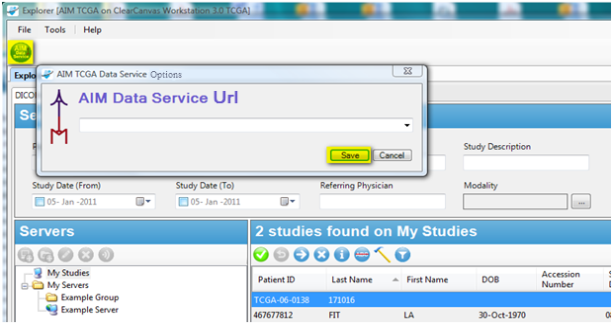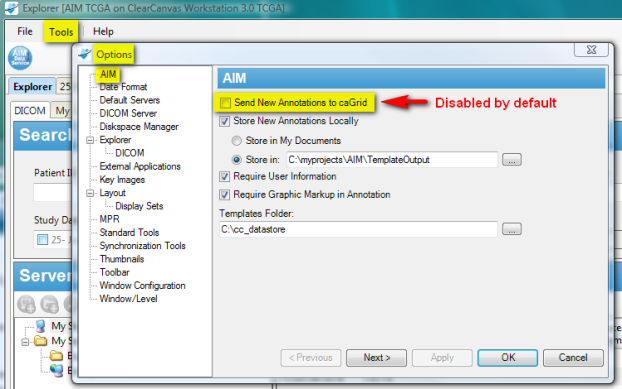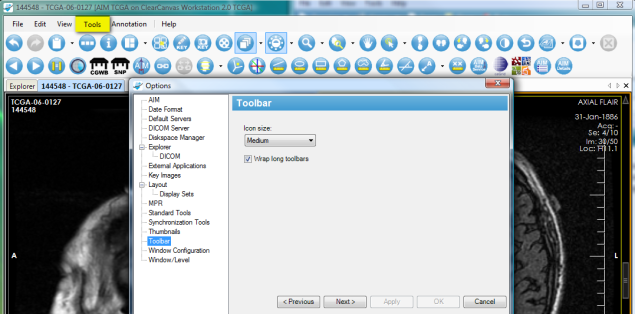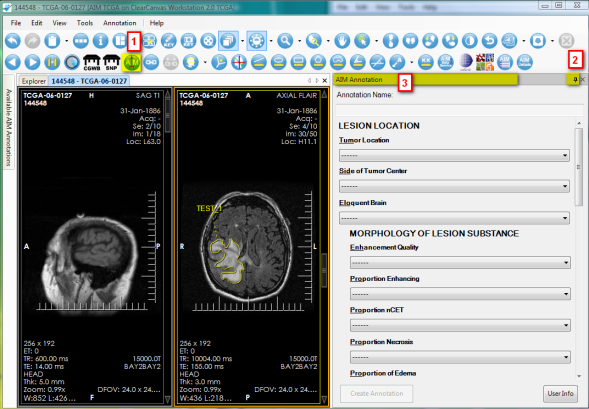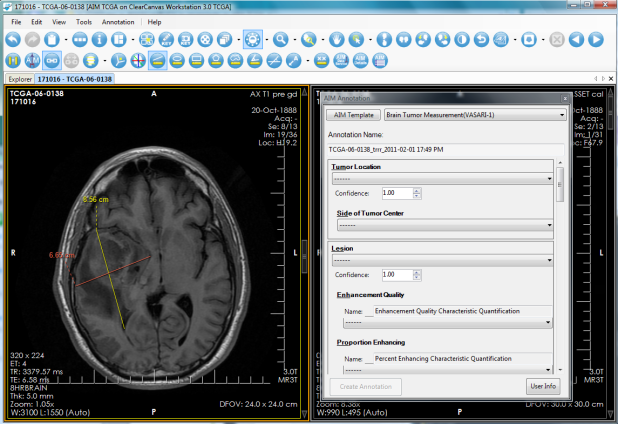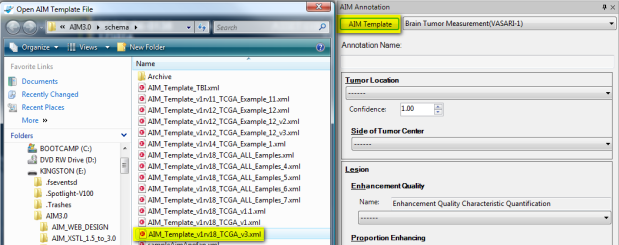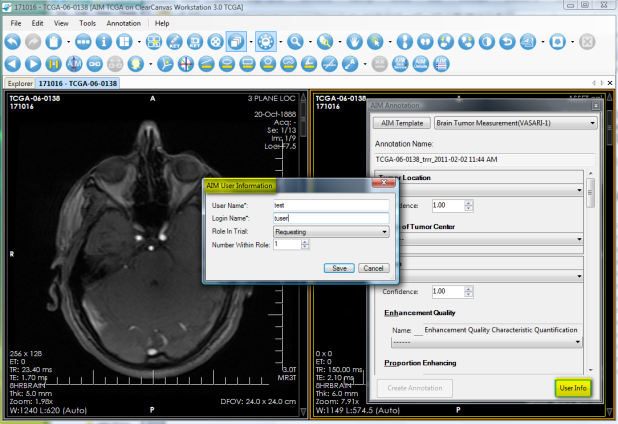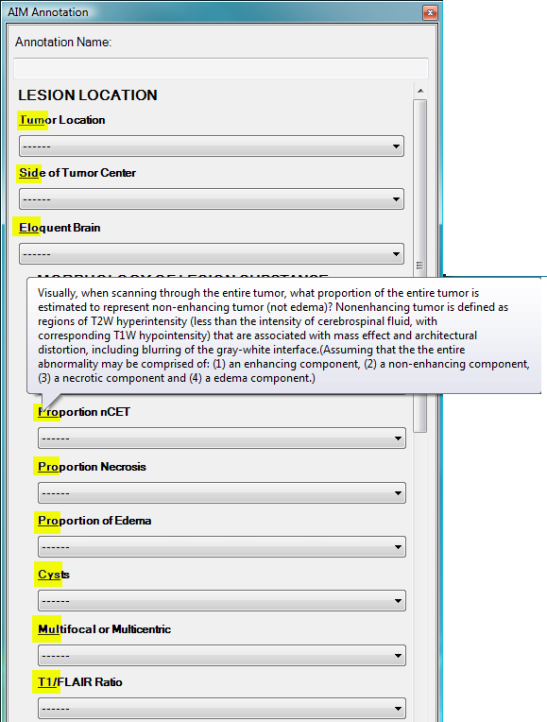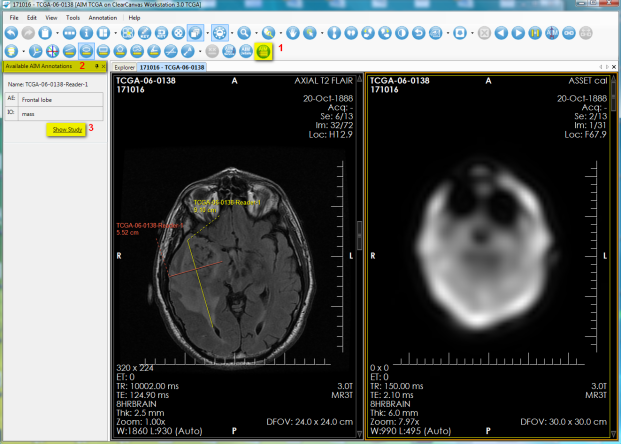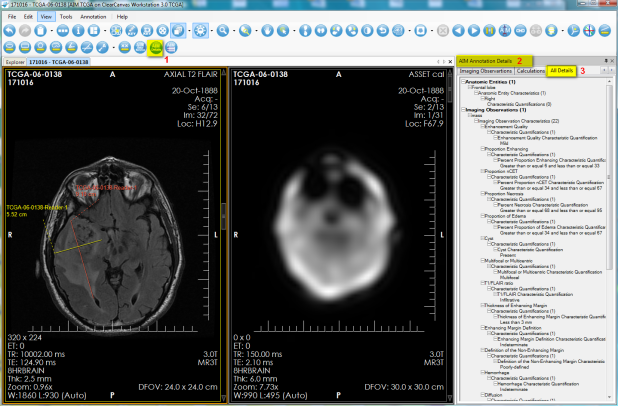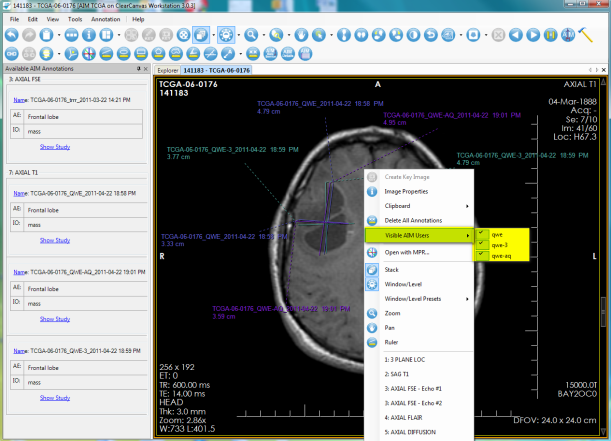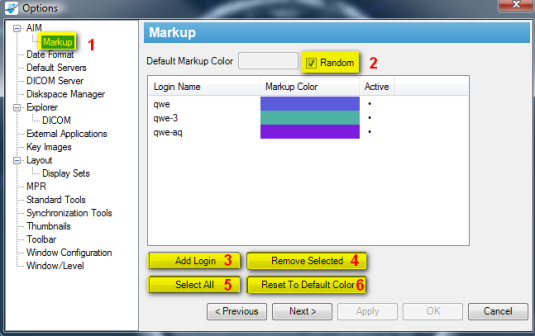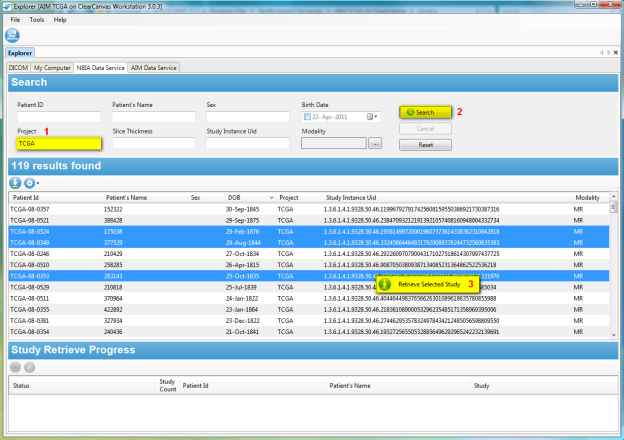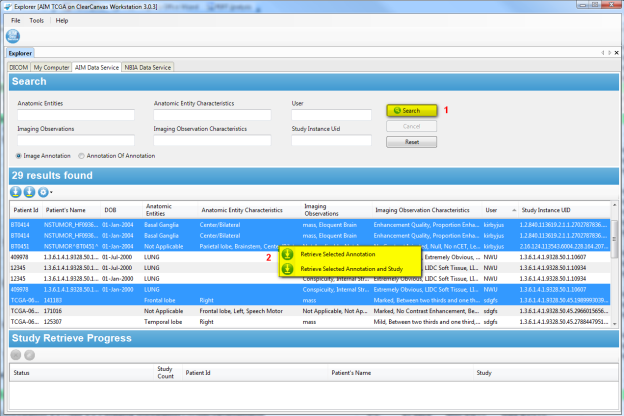Annotation Imaging Markup (AIM) on ClearCanvas Workstation 3.0.3
This document describes the unique features of AIM on ClearCanvas Workstation 3.0.3. The information presented explains key procedures for creating and working with AIM annotation objects.
The ClearCanvas workstation also has an extensive user's guide that can be found on the main menu at Help ? User's Guide
For more information on AIM and ClearCanvas, go to the following links:
https://cabig.nci.nih.gov/tools/AIM
http://www.clearcanvas.ca/dnn/
Table of Contents
Setting AIM Data Service Options
Setting AIM Options
Setting Toolbar Options
Using AIM Tools
AIM Template
Importing a New AIM Template
User Information
Detailed Description of a Question
AIM Locator
AIM Annotation Details
AIM DISPLAY MARKUPS from different users
National Biomedical Imaging Archive (NBIA) Data Service
AIM Data Service
Appendix
Setting AIM Data Service Options
The purpose of AIM on the ClearCanvas workstation is to connect to multiple AIM Data Services that can accommodate the AIM 3.0 information model. As a result, these data services are collectively known as AIM 3.0 Data Services.
While by default the workstation is not configured to connect to any AIM 3.0 Data Services, it can use the AIM 3.0 Data Service. An end user can enter any valid URL for the AIM Data Service and click the Save button to have that URL remain on the workstation for future sessions.
Click to configure the AIM Data Service. You can access the data service configuration from the explorer toolbar, shown in (Fig 1), or through an opened study's toolbar, shown in (Fig 2).
Figure 1. Access AIM Data Service Options from Explorer Toolbar
Figure 2. Access AIM Data Service Options from an Opened Study
Setting AIM Options
To access the AIM settings, on the ClearCanvas menu, select Tools ? Options ? AIM. When finished, click Apply to commit the changes. This is demonstrated in (Fig 3).
Figure 3. AIM Options
NOTE: By default, the setting for sending AIM XML documents to the AIM 3.0 Data Service is disabled. You must enable this option in order to have new AIM XML documents sent to the AIM Data Service. If you have not set the AIM Data Service destination in section I*Where is this procedure documented?, and you have not enabled the Send New Annotations to caGRID option, your existing AIM XML documents will not be sent to AIM 3.0 Data Service.*
A user may change the following AIM options, which are described in Table 1.
Option |
Description |
Send New Annotations to caGRID |
If selected, the workstation will send new annotations to the assigned caGrid location. Also see Section I, "Setting AIM Data Service Options". |
Store New Annotations Locally |
If selected, the workstation will store a copy of new annotations in the AIM XML format on the local computer. A user can assign where the AIM annotation documents can be stored on the local computer. |
Required User Information |
If selected, user credentials need to be entered before creating an AIM annotation document. |
Require Graphic Markup in Annotation |
If selected, a user must create at least one graphical drawing on an image before creating an AIM annotation document. |
Templates Folder |
If entered, the directory will be used to search for AIM template XML documents. |
Table 1. AIM Options Setting
Setting Toolbar Options
The ClearCanvas workstation allows a user to change the size of icons and show all icons on one screen. To do so, select Tools ? Options ?Toolbar . The recommended icon size is medium and you should select the Wrap long toolbars option. See (Fig 4).
Figure 4. Setting Toolbar Option
Using AIM Tools
Table 2 describes four AIM tools that are available on the ClearCanvas workstation.
Tool |
Description |
|
AIM Template displays a template based form with a set of questions and choice(s) of answers for each question. A user is able to import a new AIM template at that location. New annotation objects can be created by completely filling out this form and pressing the "Create Annotation" button. |
|
AIM Object Locator depicts available AIM objects in the currently displayed study without searching through every image in the study or series. |
|
AIM Details provides the ability to view specific areas of a selected graphic markup for an existing annotation. |
|
Closed Polygon Markup tool allows creation of a free hand graphical markup. This tool can be used in addition to existing ClearCanvas tools in creating graphical markup. |
Table 2. Available AIM Tools
AIM Template
To activate the AIM template tool in (Fig 5), click the AIM template tool button (#1). If you put the pin down (#2), you can detach the AIM Template tab by putting the mouse pointer at the header (#3) and dragging it out (Fig 5-1).
Figure 5. Activate AIM Template
Figure 5-1. Detached AIM Template Tool
IMPORTANT: When an AIM annotation is created, the following conditions are applied (based on AIM default settings in Section II "Setting AIM Options");
- A user must answer all questions presented in the AIM Annotation window.
- A graphical markup is required on an image if "Require Graphic Markup in Annotation" is selected before an AIM annotation can be saved to the AIM Data Service and/or stored locally.
- User information must be entered if "Require User Information" is selected.
Importing a New AIM Template
An AIM template XML document can be imported by clicking the AIM Template button, as shown n (Fig 6). Windows Explorer opens a predefined folder described in the Setting AIM Options section.
Figure 6. Importing an AIM Template
User Information
Author information depicts in (Fig 7) which can be changed. To use this feature, click the User Info button to activate the AIM User Information form. Enter appropriate information and click "Save".
Note: The user information will be saved on the workstation for future use. If you are sharing the workstation with another reader, you must change or at least verify that the information in the "User Info" reflects your personal credentials.
Figure 7. AIM User Information
Detailed Description of a Question
A detailed description of a question can be seen by placing the mouse pointer over the first three characters of each feature name, as shown in (Fig 8).
Figure 8. Detail Description of a Question
AIM Locator
The AIM locator, depicted in (Fig 9), allows users to see existing AIM instances available in a study. A list of available AIM instances is displayed below the Available AIM Annotations section, which is #2 in the following image. To access this feature and see an AIM annotation, click Show Study, which is #3 in the following image.
Figure 9. AIM Locator
AIM Annotation Details
The AIM annotation details (Fig 10) allow a user to examine detailed information captured in an AIM instance. To access this feature, you select an image containing an AIM instance and then click the AIM Details button, as shown in (#1). The AIM Annotation Details panel appears. This panel contains information tabs including Anatomic Entity, Imaging Observation, Calculations, and All Details. The All Details tab (shown in #3) allows a user to see information related to both Anatomic Entity and Imaging Observation and their characteristics.
Figure 10. AIM Details
AIM DISPLAY MARKUPS from different users
For a given image in an imaging study that has more than one reader interpreting and creating AIM annotations, the workstation can display every annotation while allowing you to turn off markups from a selected group of readers. (Fig 11) depicts an image with three markups from three readers. The markup from reader named qwe-3 was turned off.
A right-mouse click on the image activates a pop-up menu with a "Visible AIM Users" option to turn readers' markups on or off.
Figure 11. AIM Markup Display
ByThis whole paragraph needs to be rewritten and structured as a procedure. Very unclear. default, the workstation also displays annotations created by different users in different colors. Selecting Tools -> Options -> AIM -> Markup allows you to change which colors are used for which user's AIM annotations (Fig 12). Selected by default, the "Random" checkbox (#2) assigns a random color to each user. If you do not select the option, you can override the random color with a different color. You can also override the color used to depict one or more user's AIM annotions. The default color may be changed by clicking the button to the left of the checkbox when the checkbox is deselected. A user's color may be changed by clicking the color next to their name and selecting a new color in the color picker dialog that appears. Users not yet loaded into the list may be added to the list by clicking the "Add Login" button (#3). Selected users may be removed from the list (resetting their colors to the default) by selecting the "Remove Selected" button (#4). All users in the list may be selected by clicking the "Select All" button (#5). Selected users may have their color reset to the default color, either random or predefined as determined by the Random checkbox (#2), by clicking the "Reset To Default Color" button (#6).
Figure 12. AIM Markup Display
National Biomedical Imaging Archive (NBIA) Data Service
The NBIA Data Service (Fig 13) tab provides the ability to connect and retrieve studies from NBIA directly within the workstation. Holding the "Ctrl" key allows you to click on and select multiple studies. Right-clicking activates a feature that allows you to retrieve selected studies.
Figure 13. NBIA Data Service
Users can enter search parameters (Fig 14) based on a single value or mutiple values of Patient ID, Patient's Name, Sex, Birth Date, Project name at NCI, Slice Thickness, Study Instance UID, and Modality.
Figure 14. Search NBIA Data Service
Columns in the NBIA Data Service page can be selected or deselected to display or hide an available result. Fig 15 depicts that all available columns for the service have been selected.
Figure 15. Select NBIA Data Service Display Columns
AIM Data Service
The AIM Data Service tab (Fig 16) provides the ability to connect and retrieve AIM XML documents from an AIM 3.0 Data Service (see "Setting AIM Data Service Options" in Section I). It also allows a user to retrieve both AIM documents and studies from NCI's NBIA . Right-clicking activates a feature that allows you to retrieve studies.
Figure 16. AIM Data Service
You can enter search parameters (Fig 17) based on a single value or mutiple values of Anatomic Entities, Anatomic Entity Characteristics, the User who created the AIM XML documents, Imaging Observation, Imaging Observation Charactersitics, and Study Instance Uid. The AIM Data Service search is case-sensitive.
A type of AIM XML document, Imaging Annotation, or Annotation Of Annotation, must be selected. The default value is Imaging Annotation.
Figure 17. Search AIM Data Service
Columns in the AIM Data Service page can be selected or deselected to display or hide an available result. Fig 18 depicts that all available columns for the service have been selected.
Figure 18. Select AIM Data Service Display Columns
Appendix
For more information on how to set up AIM, information on the AIM Template ManagerI thought you had settled on AIM Template Manager as the name? I thought AIM Template Creator was the old name., and AIM Template Manager software, please go to the following links:
- AIM Template Software Setup manual,
https://gforge.nci.nih.gov/frs/download.php/9167/AIMTemplateSoftwareSetup.zip
- AIM Template Creator Software,
https://gforge.nci.nih.gov/frs/download.php/9166/template_editor.war

